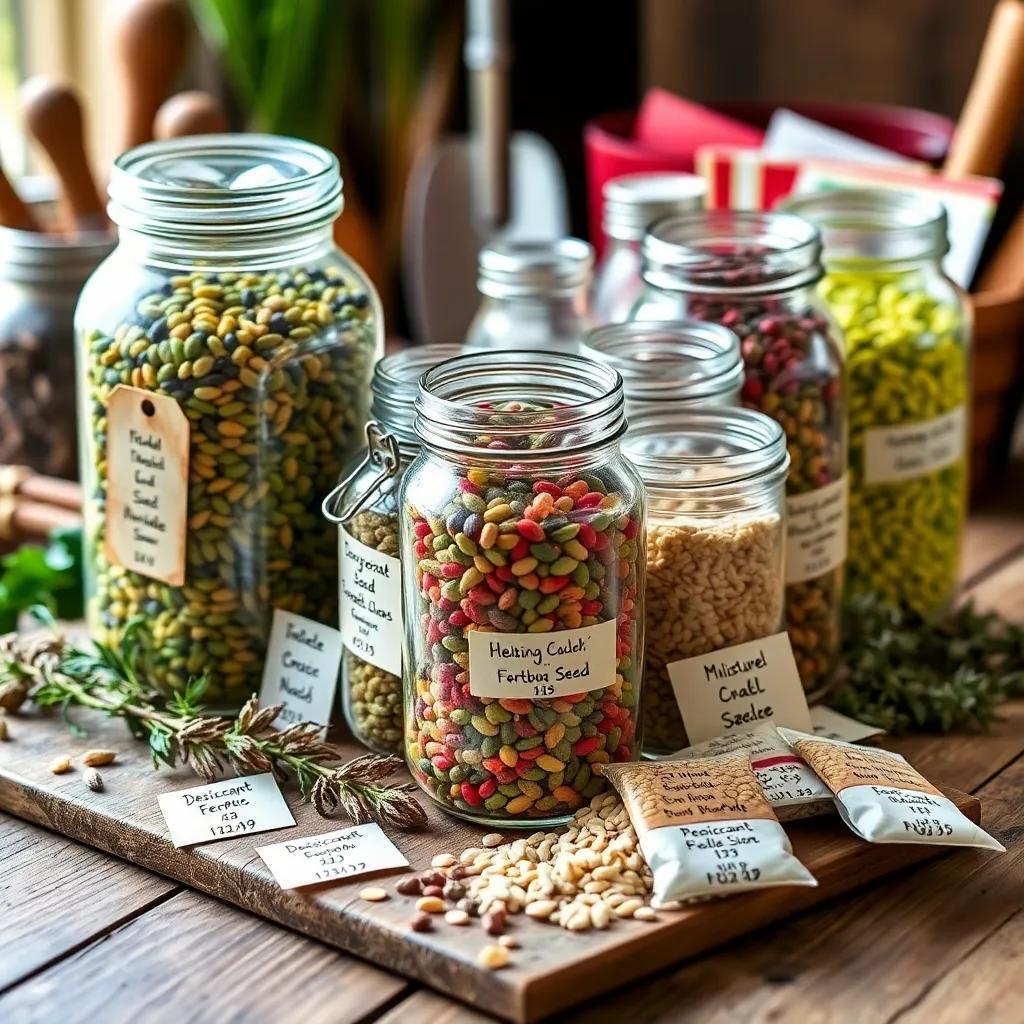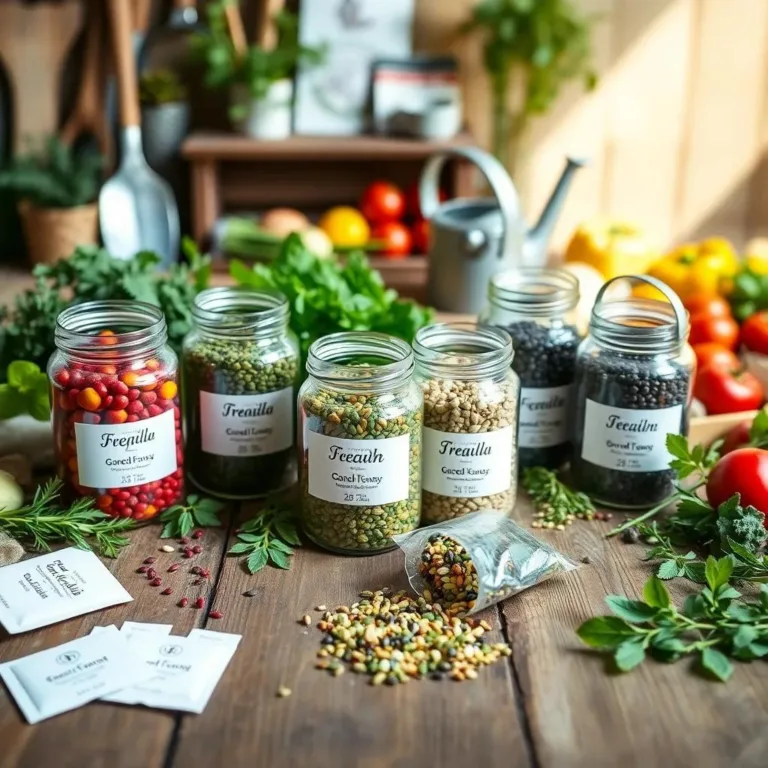Are you ready to become a seed-saving superstar? Whether you’re a gardening newbie or a seasoned pro, knowing how to store seeds and keep them fresh is key to a thriving garden! Join me as we explore the fascinating world of seed longevity, storage tips, and which seeds can stick around for years—let’s make sure your garden flourishes with every planting!
Factors That Affect Seed Longevity
Understanding what affects seed longevity is super important for anyone who loves to garden! After all, seeds are the little treasures that sprout into beautiful plants. So, let’s talk about a few key factors that can make your seeds last longer.
- Seed Type: Not all seeds are created equal! Some seeds, like lettuce and onion, can be a bit finicky and might only last a year or two. Others, like tomatoes and beans, are champs at holding onto their life for several years. It’s like the difference between a young sprout and a wise old tree!
- Seed Quality: If you want your seeds to last, start with the best! Fresh, high-quality seeds are like fresh ingredients in a recipe—they make all the difference. Make sure to buy your seeds from reputable sources, and check for any signs of damage.
- Humidity: Moisture is the enemy! Too much humidity can turn your precious seeds into mush. I mean, who wants that? Keep your seeds in a dry spot, and if you can, throw in some desiccant packets to absorb any sneaky moisture.
- Temperature: Seeds thrive in the cool! Storing them around 32°F (0°C) to 41°F (5°C) is ideal. Avoid spots that go from hot to cold, like garages or attics, which can really throw a wrench in their longevity.
- Light Exposure: Just like how I love a cozy blanket fort, seeds love to be kept in the dark! Prolonged exposure to light can confuse seeds and may cause premature germination. Store them in opaque containers to keep them snug.
By keeping these factors in mind, I can help you maintain the lifespan of your seeds, making sure they’re ready to sprout when you are!
Best Practices for Seed Storage
Now that we know what affects seed longevity, let’s chat about how to store them properly! Following the right practices can keep your seeds fresh and ready for planting. Here are some tips that I swear by:
- Cool and Dry: Remember the perfect temperature we talked about? Keeping seeds in a cool, dry place is key! Find a cozy corner in your home where temperatures stay steady and the humidity is low.
- Quality Containers: Think of your seeds as delicate treats—use airtight containers like glass jars or moisture-proof bags to keep them safe. I always avoid plastic bags, since they can trap moisture!
- Desiccants Are Your Friends: Add some desiccant packets or even a scoop of dry rice to soak up any extra humidity in those containers. It’s like adding a pinch of salt to your favorite dish!
- Labeling: Organization is everything! I like to label my seeds with the name and the date they were collected. This way, I know exactly what I have and when it was harvested—no surprises!
- Check Regularly: Make it a habit to peek in on your stored seeds. Check for any signs of moisture or pests. If any seeds look suspicious, toss them out! It’s better to be safe than sorry.
By following these best practices, you can feel confident that your seeds will stay fresh and ready to sprout when it’s time to plant. Happy gardening!

Common Methods for Storing Seeds
When it comes to keeping seeds fresh and ready for planting, I believe in mixing creativity with practicality. There are several common methods to store seeds, and each one can be a fun little project! Let’s explore some of these methods together.
- Paper Envelopes or Bags: A super simple and cost-effective way to store seeds is using paper envelopes or bags. Just pop the seeds in, label them with the seed type and date, and place them in a cool, dry spot. Avoid plastic bags, though—they can trap moisture and ruin your seeds! If you have lots of different seeds, you might need a filing system that would make a librarian proud!
- Glass Jars: For a more stylish option, try using glass jars or airtight containers. Not only do they look great on a shelf, but they also protect your seeds from moisture and pests! Before putting seeds in, make sure the jars are clean and completely dry. You can even add a desiccant packet to keep things nice and dry.
- Freezer Storage: For long-term storage, the freezer can be an option! Just remember, seeds need to be fully dry before you seal them in moisture-proof containers. When you pull them out to use, let them reach room temperature first to avoid condensation—just like thawing out that last slice of pizza!
- Seed Vaults: If you’re serious about seed saving, consider investing in a seed vault. These high-tech storage containers keep your seeds safe from light, moisture, and pests. Some even come with temperature control! They’re perfect for those who want to protect a large collection.
- Refrigerator Storage: For shorter-term needs, your refrigerator can work wonders! Store seeds in airtight containers or resealable bags along with a desiccant packet. Just be careful, as not all seeds thrive in chilled environments. It’s always good to do a little homework on the specific needs of your seeds.
By knowing these different methods, you can choose the best way to store your seeds based on your gardening plans. It really helps to keep them organized and ready whenever you feel like planting!
Testing and Ensuring Seed Viability
Now that we have our seeds stored like little treasures, it’s time to talk about testing their viability! After all, what’s the point of planting seeds that won’t sprout? Let’s explore some fun and simple ways to check if our seeds are still good and ready to go!
- Germination Test: This is my favorite method! Grab a few seeds from your stash and plant them in a small pot. Keep them in a warm spot and give them some water. After a week or so, check how many sprouted. If most of them did, you’re good to plant! If not, it might be time to retire those seeds.
- Float Test: Have you ever tried the float test? It’s super easy! Just fill a bowl with water and toss in a few seeds, especially larger ones like beans. If they float to the top, they’re likely not viable. Seeds that sink are more likely to be good to go!
- Seedling Vigor Test: If you’re curious about seedling health, you can also do a seedling vigor test. Plant a handful of seeds and observe the growth of the seedlings. Healthy, robust seedlings indicate that the seeds have good viability.
- Tetrazolium Test: For a more advanced technique, you can use the tetrazolium test—though this one requires some special equipment. It involves soaking seeds in a tetrazolium solution that colors the living parts red or pink. If they’re white, it’s time to say goodbye!
- Regular Checks: I like to keep checking on my seeds throughout the year. This way, I can stay updated on their health and toss out any that are no longer viable. It helps me keep my garden organized and full of promising plants!
By testing seed viability regularly, I can ensure that I’m planting the best seeds possible. It saves time and boosts my gardening success, which is always the goal!
Seeds with the Longest Shelf Life
Some seeds are like the wise, old sages of the garden—they can last a long time! Understanding which seeds have the longest shelf life can really help us make smart choices for our planting endeavors. Let’s look at some of these remarkable seeds that can stay viable for years.
- Beans: Certain bean varieties, like kidney beans or black beans, can last up to 5 years when stored under the right conditions. They’re tough cookies and perfect for a variety of dishes!
- Corn: Corn seeds can last about 2 to 3 years if kept in a cool, dry spot. Just remember, sweet corn doesn’t hold up as well as field corn, so check your seed packets for specifics!
- Squash and Pumpkins: These seeds are pretty sturdy, too. They can last from 3 to 5 years if stored properly. With a hard shell, they’re built to withstand the test of time!
- Tomatoes: Tomato seeds are a gardener’s favorite and can last around 4 to 5 years. I find that they produce fantastic plants with delicious fruits, making them a must-have in any garden.
- Herbs: Many herb seeds, like basil and parsley, can stay viable for several years—often around 2 to 4 years. They’re a delightful addition to any garden, adding flavor to our meals!
While these seeds are known for their longevity, it’s still wise to check on their viability and conditions regularly. By focusing on seeds with longer shelf lives, I can plan my garden better and enjoy the fruits of my labor for years to come! Happy planting!

